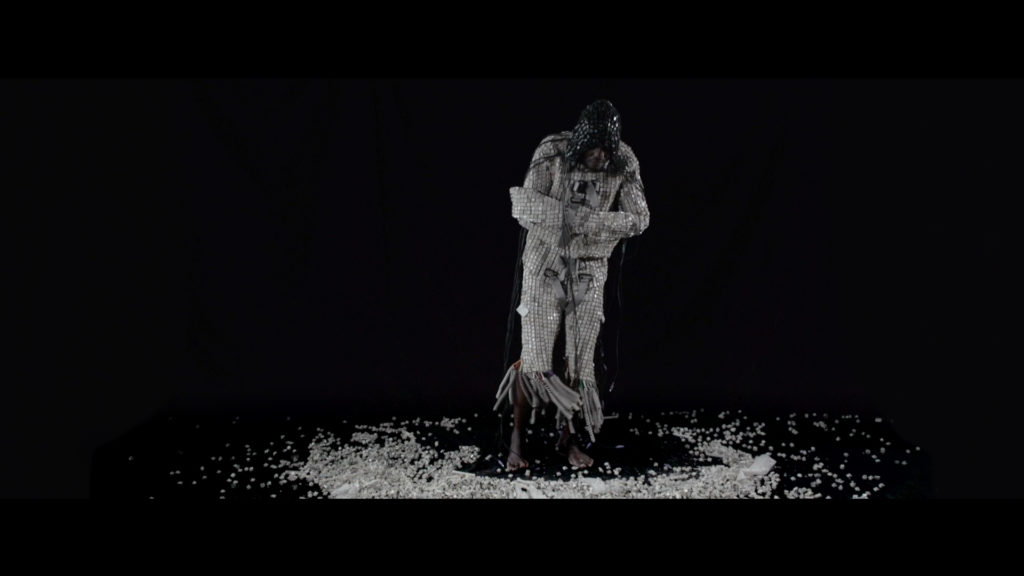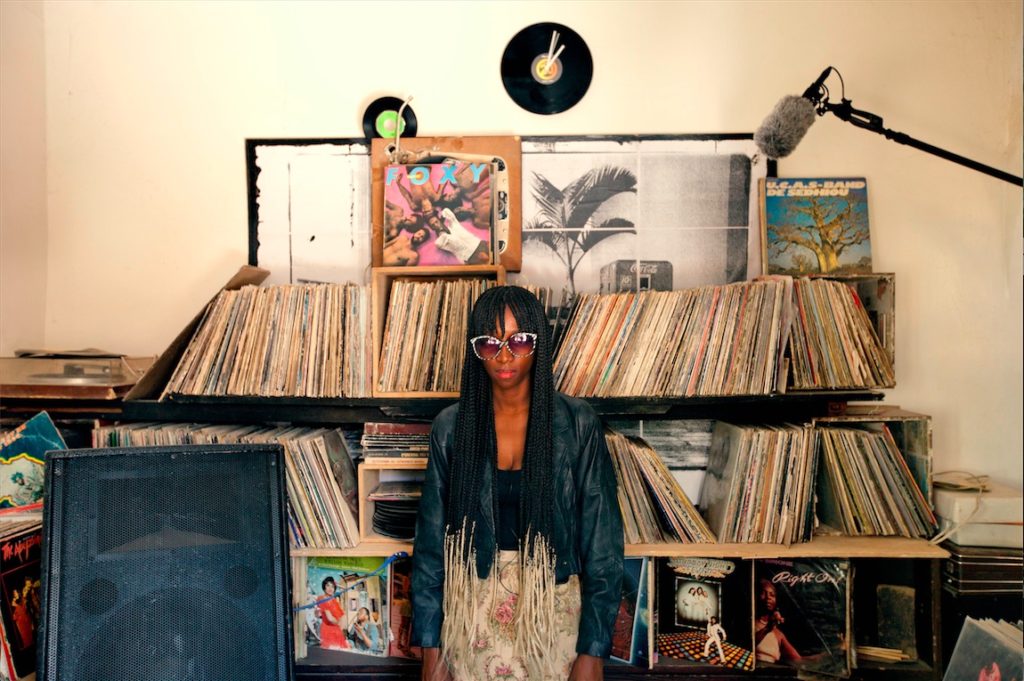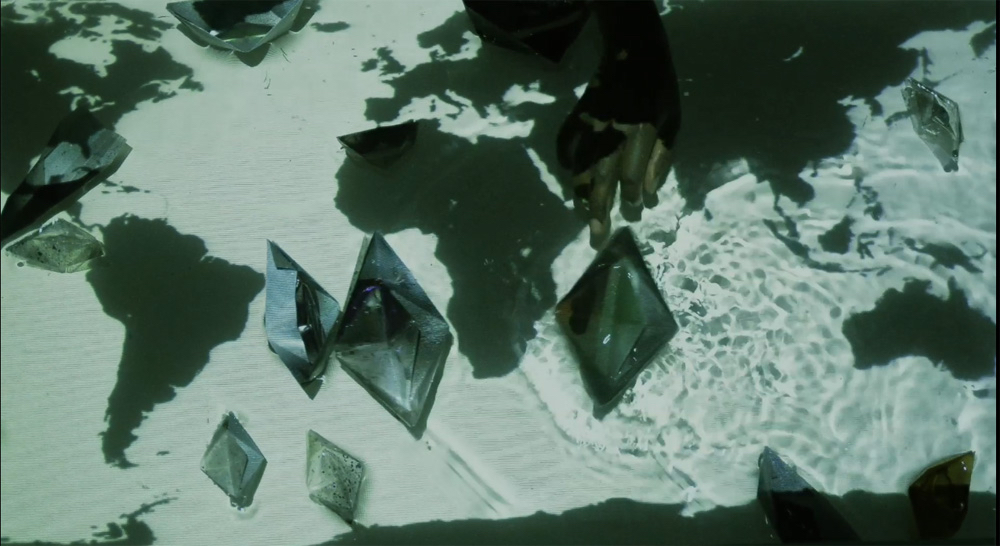
“Filmmaking arrived in Africa with the intended function of ‘civilising’ the African population. The way that they would do this was through the introduction of western norms and ideals portrayed in film, which was a simultaneous strategy of erasure and dismissal of African existence as this exotic and superstitious experience. The role of film in this sense was a way to render our own stories useless to us.”
Filmmaker Mzonke Maloney in his conversation with art critic Thuli Gamedze
Afripedia: Senegal film still Omar Victor Diop, 2014 (28-min-30-Courtesy-of-Stocktown-Films)
African Art and Film Practices: Processes of Colonial Creative Containment
A conversation between Thuli Gamedze and Mzonke Maloney
This conversation comes out of a growing interest with the institutionalised art world industry in Africa, most of which are my observations of Cape Town and Johannesburg, where commercial galleries, studios and exhibitions make it so clear that the conditions for ‘fine art’ display, absorption and enjoyment are still very limited to some contemporary version of ancient colonial ideology or structure. White cubes form the ‘neutral’ platform for the display of artworks in our most recognized commercial contemporary art galleries, the sites from which these works are exchanged globally at Art Fairs amongst the great great grandchildren of those who once scrambled for Africa. These exhibitions are attended well and almost exclusively by our proportionally minimal white population, while proportionally the number of black artists on display continues its exponential growth, serving the insatiable market of black creative production for cultured white gazers.
More than frustration though, since at this point, this system is tiringly well documented, I have become interested in how we got here, and how this really bizarre status quo is what we understand as South African art practice. So in engaging with the structure and history behind this completely separatist art phenomenon, I thought it could be interesting to have a conversation with my friend Mzonke Maloney, a filmmaker, to think through the various colonial processes that have affected and shaped the African film industry, alongside those that have shaped the institutional art industry, in order to gauge some kind of parallels in colonial creative suppression and containment on the continent.
As articulated by Olu Oguibe in his paper ‘Appropriation as Nationalism in Modern African Art’, art, or rather the autonomous creativity of the colonized subject has historically been seen as a threat to the colonial project in its potential to spur progress independent of the oppressors, and clear a path of epistemological liberation (2002:244). Because of the mode in which the text traces colonial strategies of cultural repression over time, I think it could be important to use this information to historicize the current ‘state of art’ as the next step of this trajectory.
Thuli. One of the initial approaches of colonialists in dealing with the problem of African creative autonomy, particularly in Nigeria, was simply the crude and uncultured act of destroying traditional art objects that were found. This literal erasure of history provided the space for Europeans to re-invent a conception of the African subject as one without culture, innovation or creativity. (Oguibe, 2002)
Mzonke. in the case of the film industry, which essentially functions as another strand of art production, the medium was introduced to Africa by the colonisers. I think it is sensible to make that particular distinction early on, because whereas other art practices were already in existence, the trajectory of film had its genuine origins in Europe and the Americas.
T. One of the main methods of colonialism was the formalization of education. Colonial schools, often run by missionaries, became the ‘standardised’ and authoritarian site for the dissemination of knowledge. As time went on, formal education took a number of different forms, but as a whole, this ingenious move has perhaps been one of the most influential in the reproduction of African subjugation over the years. Formal education was constructed with a power dynamic in mind- a way to measure intelligence, progress, and legitimacy according to a Eurocentric standard (Oguibe, 2002: 245). Within the establishment of these schools, art education was strategically excluded, meaning that there was no way for an African person to obtain ‘legitimate’ skills in art production under early colonial rule.
M. Filmmaking arrived in Africa with the intended function of ‘civilising’ the African population. The way that they would do this was through the introduction of western norms and ideals portrayed in film, which was a simultaneous strategy of erasure and dismissal of African existence as this exotic and superstitious experience. The role of film in this sense was a way to render our own stories useless to us.
T. The same kind of erasure happened through formalized western education- African indigenous knowledge and experience was sidelined and dismissed in favour of the culture of the colonist.
M. Yeah… So, going back the early 1900s, a large portion of the films in Africa were completely subjected to European indoctrination, from war propaganda to proselytism. And so what we saw is that the filmmaking on the continent started to take on this extremely different dialect compared to that which was being instituted in Europe, or the Americas. The way film functioned in these spaces was as commodity and for the purpose of entertainment, while what it was becoming here was very instructive and rigid. Basically, through film, the African cultural experience was replaced by the introduction of these alien sensibilities presented as normative.
T. I find it quite interesting that the colonial approach seems to be that whether or not a nation or region was clearly already producing its own creative work, it was of the greatest necessity that that be erased. So, through the destruction of art, and the exclusion of it from curricular, essentially the colonial strategy was the same as it was with the introduction of film to Africa- to control the practices, and use them on their own terms. And it seems that, with film, it was exported not to introduce art practice, but rather as a mode of indoctrination. It is strange, I feel, that regardless of the practices already existing, colonialists tend just to swoop in and ‘de-historicise’ you.
In terms of visual art, of course, the static nature of this ‘banning’ of art education in slowly nationalising colonies was unsustainable, which lead to a moment in a number of countries where the dichotomy of African craft-making versus European art practice was set up. This attempt at a new kind of control might be seen as a partial assimilation, described as the process in which the native could begin to mimic European culture- through the mass hand-making of objects that resembled art but did not share in the wonder of the singular art object- and so fundamentally would just find themselves in a new position of servitude to the coloniser, even if presenting as closer to this ‘norm’ (Oguibe, 2002: 244).

Jim Chuchu, Kenya, Homecoming, film still.
M. Yeah, I think that this reflected a parallel in the film industry because what happened towards independence and during the postcolonial phase of African cinema, when people were less influenced by what was happening in Europe and America, was that something new emerged. However, in a similar way to this notion of craft, a kind of repetitive use of the visual language we were taught by Europeans lead to the development of a very didactic style of cinema, where the focus was extreme nationalism. Film then was used as a social tool in a similar way it was used as a mechanism contributing to the production of the colonial structure. It was still not an independent art form. There was this similar feeling of mimicry to what you are describing with this art vs craft dichotomy. The method and medium remained, although the subject of the conversation changed. Now you were seeing filmmakers project this extreme African nationalism into these pictures but still in this very rigid and contained manner.
T. I know this is kind of a thought experiment to see what kind of information each story helps us pull out of the whole but it is really interesting to think about these relationships. Oguibe talks about this guy, a colonialist called Kenneth C Murray, who entered schools in Nigeria with the intention of putting a stop to the work that this black artist Aina Onabolu had been teaching. Onabolu had been to Europe and learnt a number of their art processes and practices, and had returned to Nigeria as an art educator to share his knowledge. What Murray did in the school then was to subvert the form of conscious production that Onabolu had been promoting in favour of a ‘naïve’, or unconscious form of making, that while it might have mimicked western style, was almost ‘kitsch-esque’. The idea that Onabolu was introducing conscious production that informed style and independent progression was seen as a threat, and therefore eliminated. And this is one way that the narrative of African ‘authentic creativity’, constructed by the coloniser entered the white imagination, as a way that continues to deny the existence of conscious and progressive creativity in the colonies. (249)

Maurice Mbikayi, Web Jacket, film still, 2015 (9-min-Courtesy-of-the-artist-and-Officine-dell’Immagine)
M. I suppose with film, there are these histories, particularly post-colonialism where you find for instance, in Francophone colonies, the French had left behind functional infrastructure for the production of the kinds of film they had produced. Of course you might then say that this was the chance for Africans to now create their own filmmaking styles but then you have to look at the politics and socio economics of these countries, because that was what was influencing the visual languages of these films, that were almost an anthropological tool for Africans, and not necessarily made for entertainment or anything else… So our relationship with the idea of cinema and participating in cinema is entirely marred by the ideology of the colonisers, and therefore we haven’t seen a generation raised off of African cinema to then develop a language of what that might mean now.

Afripedia: Senegal film still-Selly Raby Kane, 2014 (28-min-30-Courtesy-of-Stocktown-Film)
T. In visual art, there do exist a number of creative practices that are alive, but now, say in South Africa, if these practices enter into the institution, still the space symbolising ‘legitimacy’, they are appropriated in a way that, again, contains them and makes them less dangerous. There is so much work coming from black south African artists that is so subversive, and speaks directly to the kind of power relation it inevitably is forced to play into. And, to me, this is the scariest relationship because after all these efforts to stop us making art, now we finally can but they’ve still got us!
Even within South Africa, the infrastructure exists- galleries and museums, exclusively in ‘white’ areas- that means African art can still be exoticised on its own land. There is a monopoly on art’s circulation that means its scope within the global industry is bound to a certain contextualization of it.

Jackie Karuti, There Are Worlds Out There They Never Told You About, film still, 2016 (3-min-31-Courtesy-of-Circle-Art-Gallery)
M. I get that, and there are similar systems at play in the film industry, although an important distinction in film is that the work we are making here does not really enter the same global mainstream that it seems African contemporary art does. But I think that that is down to the systems that have been in place that continue to reinstate these colonial ideologies. One of these systems is called ‘block booking’. What happens in this process is that distributors buy a film from Africa, and then they sell it to cinemas that pre-buy the tickets. The majority of these cinemas are European or American based and this has obviously not only affected the level of reception that African films receive in Africa, but has also changed the visual language which African filmmakers feel is most effective to attract foreign attention. That is where the money is of course, as these films rely on the one-off sale, rather than on the ticket sale basis that Hollywood and European films use.
So what then happens is that African films don’t really exist in Africa. They only exist as these exoticised exports for foreign markets, and that really is the only space in which they have relevance.
T. That is a very intense system, and really exploitative, in the sense that it seems to set up a perpetual cycle in which African filmmakers will never have the resources or time to be working on their own practices. Resources are lacking enough that Africa will continue to provide whatever cultural product is in demand to Europe and America, because it takes time and money to set up independent infrastructure…It’s just this continued underdevelopment. I feel that through sending our work off into the global market, African artists encounter a similar problem- there are limited means to get by as an artist if you cannot sell your work, and unfortunately the monopoly on that market comes with a very specific (and violent) gaze…
M. Hmm, yeah, these problems are pervasive across cultural practices it seems. Essentially the only way that this will change is if we start to develop new models, in film, new models of distribution, development, marketing and curation, and importantly models that take into account the economic boundaries we are working with. There are a number of issues outside of production though- audience accessibility to cinemas and facilities that show African film.
When you think about soaring ticket prices, inaccessible theatres, this overwhelming foreign presence on African screens, it becomes so difficult to negotiate the disconnect between regular everyday Africa and the world of cinema. And that’s at the heart of what needs to change. I just wanna see African films made for Africa, shown to Africans, within Africa.
T. I guess that I would be hoping to see that kind of thing shifting in the art world as well. It’s almost this constant robin-hood-esque negotiation of trying to appropriate global capital half of the time, and otherwise to be re-situating it here for the projects we are trying to work on for this context now.
